All entries for May 2022
May 26, 2022
Spoliated spolia: the tropaea Marii on the Capitoline Hill, by Kieren Johns
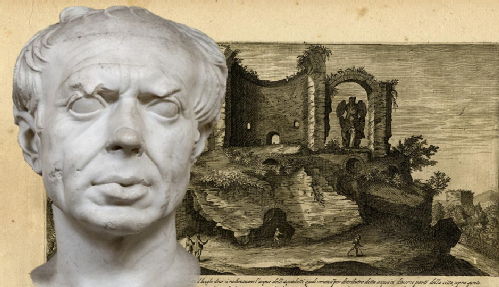 |
Portrait of so-called Marius, 1st century BCE, restored by Alexander Trippel, now in the Musei Vaticani (https://commons. wikimedia.org/wiki/File: Marius_Chiaramonti_Inv1488.jpg) with "A view of the trophies of Marius" Plate 25 in Sadeler, M. (1660) Vestigi delle Antichiat di Roma, Tivoli, Puzzuolo et altri luochi (Roma: G. Giacomo de Rossi). |
Today, if you walk up the picturesque Cordonata Capitolina staircase towards the summit of Rome’s Capitoline Hill, you will be confronted by the imposing equestrian statue of the second-century CE emperor, Marcus Aurelius. An array of other ancient statues adorn the Piazza del Campidoglio, too. The top of the staircase is flanked by the Dioscuri, statue of the twin deities Castor and Pollux. Further along the balustrade are two other marble compositions. These depict “tropaea”, or “trophies”, which were displays of captured arms and armour that monumentalised Roman military victory.
 |
An illustration of one of the tropaea from the balustrade of the Campidoglio, attributed to Pietro da Cortona ca. 1625-30. Image from Royal Collection Trust. |
These arrangements are one of the most recognisable motifs in ancient iconography, featuring in an array of visual media, including marble reliefs, through to gems and coinage, across the centuries of the empire’s history. Representing spolia, the spoils of war captured from Rome’s defeated enemies, they symbolise Roman might. However, the examples on the Campidoglio have a curious history of display and movement in the city.
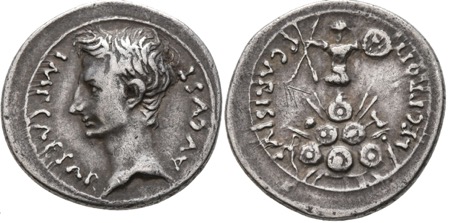 |
RIC I2 Augustus 4B: Denarius minted at Emerita by P. Carisius in 25-23 BCE. Obverse portrait of Augustus, reverse depiction of a trophy erected on mound of shields. Image from: Department of Numismatics and Monetary History at the University of Vienna.
|
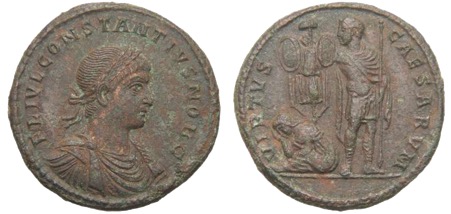 |
RIC VII Rome 345: Bronze medallion minted at Rome in 333-335 CE. Obverse portrait of Constantius II, reverse depiction of Constantius II erecting trophy with seated female figure. Image from: Münzkabinett Berlin. |
The Capitoline tropaea have been in situ on the Campidoglio since 1590, when they had been moved on the orders of Pope Sixtus V; they’re visible in Giovanni Paolo Panini’s View of the Campidoglio from 1750. When they were moved in the sixteenth century, an inscription on the underside of one of the ensembles indicated that the monument was made of marble quarried during the reign of Domitian in the late first century CE. Despite this, they were – and indeed still are by many – commonly referred to as the ‘Trophies of Marius’.
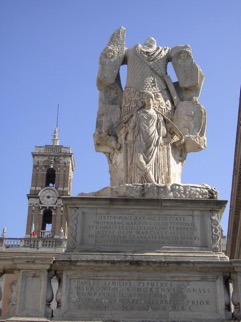 |
The right-hand tropaea as it appears today on the Campidoglio in Rome.(https://commons.wikimedia.org/wiki/File:Trofei_di_mario_a_ campidoglio.JPG) |
The Republican general had erected a number of monuments to commemorate his triumphs, first over Jugurtha and the Numidians (104 BCE) and then over the Cimbrians, defeated at the Battle of Vercellae (101 BCE). His political opponent, Sulla, had destroyed these monuments in the 80s BCE, but they were restored by Julius Caesar, during his aedileship, in 69 BCE, as recorded by Suetonius, Valerius Maximus, and by Plutarch: “he [Caesar] had images of Marius secretly made, together with trophy-bearing Victories, and these he ordered set up on the Capitol” (Caesar, 6.1).
These literary accounts have contributed to the modern misnomer. Although there were tropaea or monumenta Marii, the exact location of these monuments remains unknown. In reality, as noted above, these tropaea date to the late first century CE, and were therefore part of a now-lost triumphal monument, dedicated to either Domitian or Trajan. The dating is further indicated by the stylistic similarities between the shields on the Capitoline tropaea and those depicted on the base of Trajan’s Column.
 |
 |
| Sides 2 and 3 of the base of Trajan’s Column in Rome. The iconography of captured arms provides a useful point of comparison with the so-called Trophies of Marius on the Capitoline. Image from University of St Andrews. | |
Later, in the first half of the third century CE, the trophies were moved for the first time. They were taken from the Domitianic/Trajanic monument and repurposed as part of a monumental nymphaeum on the south-eastern slope of the Esquiline Hill. Built at the point where the via Labicana and via Praenestina merged (today’s Piazza Vittorio Emanuele), this colossal water fountain was a project of the last Severan emperor, Severus Alexander (r. 222-235 CE).
Built in opus latericium and covered in marble ornamentation, only remains of the brick structure survives today, although the monuments former prestige is clear from the size of the remains. In antiquity, the nymphaeum comprised of four levels; a ground level basin was fed by a total of seven fountain niches, five frontal and two on either side. A quadriga was situated on the very top of the structure. A good impression of the nymphaeum’s overall appearance is provided by an aureus of Alexander, minted in 226 CE.
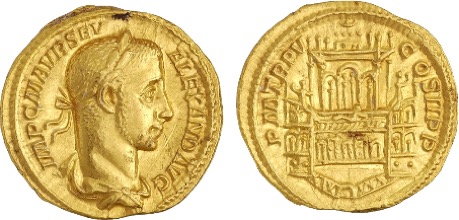 |
RIC IV Severus Alexander 58: Aureus minted at Rome in 226 CE. Obverse portrait of Severus Alexander, reverse depiction of the nymphaeum of Alexander, with details of statue decoration. Image from American Numismatic Society. |
On the fourth level, a central niche featured a sculptural group of the imperial domus and the god Oceanus, who was depicted reclining. However, it remains conjectured as to whether this would have represented Alexander with his wife, Sallustia Orbiana, or with his grandmother, Julia Maesa. The role of Maesa and her daughter, Julia Mammaea (Alexander’s mother) in the emperor’s court remains the subject of ongoing debate, though notions of her overbearing influence increasingly appear to be historiographic tropes. In two lateral niches, either side of this central imperial statue group, were the tropaea.
The reuse of this overtly militaristic iconography in Alexander’s reign is striking. Although the emperor enjoys a largely positive reception in both ancient and modern assessments of his reign, his reputation as a military leader is wholly less positive. Indeed, this is frequently presented as the prime catalyst for his assassination in 235 CE: the legions in Germany effectively shifted their loyalty to the bellicose career soldier, Maximinus Thrax.
Despite this, it has been convincingly noted that the façade of the nymphaeum, with its three niches would have resembled a triumphal arch. The inclusion of the tropaea, repurposed from their original architectural contexts, would have contributed to this impression significantly.
 |
"A view of the trophies of Marius" Plate 25 in Sadeler, M. (1660) Vestigi delle Antichiat di Roma, Tivoli, Puzzuolo et altri luochi (Roma: G. Giacomo de Rossi). |
This movement and re-use of architectural material means that the tropaea, an artistic representation of spolia, became – in themselves – spolia. This is the term used to characterise artistic and architectural material re-used in new contexts and is characteristic of Roman practices from the fourth century CE onwards, most notoriously in the Arch of Constantine’s use of a plethora of earlier imperial material).
Specifically, these tropaea illustrate the complexities in identifying types of spolia, specifically, whether they might be in re, or in se. This was a distinction first identified by Richard Brilliant, as part of his analysis of the pedestals in the Boboli Gardens in Florence; these monuments had been spoliated from the Arcus Novus in Rome to decorate the Renaissance gardens. Brilliant’s analysis distinguished between the use of spolia as merely a form of architectural reuse (i.e. spolia in se), and the communicative and ideological capacity of re-used architectural material (i.e. spolia in re).
The movement of the tropaea to this new architectural context provided Alexander with the means to augment his own status. The nymphaeum was a public benefaction of the emperor’s generosity and a billboard for the imperial domus, while the tropaea asserted that the emperor commanded the support of his soldiers. Because of this, one might wonder whether Alexander’s use of the tropaea served as an assurance of his authority over the praetorians. Cassius Dio describes how the guards had rebelled early in his reign, and the fires they started reputedly threatened the city.
More generally, if the tropaea were from a Trajanic monument, they may have allowed Alexander to generate welcome associations with the optimus princeps. If they were taken from a Domitianic monument, then these tropaea would fit into a pattern identifiable elsewhere in Alexander’s Rome. The emperor had already overseen the renovation of the thermae of Nero on the Campus Martius, and the baths quickly became known as the thermae Alexandrinae; architectural reuse had again allowed for the creation of a new narrative of imperial generosity.
Ultimately, the so-called Trophies of Marius – the spoliated spolia – present a wonderful insight into the complexities of ancient Rome’s topographical history. The modern misnomer, although a fascinating indication as to how sixteenth century Romans mined the ancient texts for information and inspiration, nevertheless belies a rich legacy of artistic and architectural interaction between Rome’s emperors and their architectural legacies.
Further reading:
Brilliant, R. (1982) ‘I piedistalli del giardino di boboli: spolia in se, spolia in re’, Prospettiva, 31:2-17.
Claridge, A. (2010) Rome. An Oxford Archaeological Guide (Oxford): 265.
 |
This post was written by Kieren Johns, who has recently submitted his PhD at the University of Warwick and is awaiting his viva. His research presents an investigation of the epigraphic representation of Roman emperors in the period 180 to 235 CE, or from the reign of Commodus to Alexander Severus, supervised by Professor Alison Cooley and Dr Clare Rowan. You can read more about his research interests, including papers presented, on his student profile. |
 Matthew Evans
Matthew Evans

 Please wait - comments are loading
Please wait - comments are loading
 Loading…
Loading…